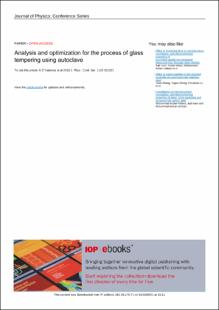Mostrar el registro sencillo del ítem
Analysis and optimization for the process of glass tempering using autoclave
| dc.contributor.author | Acevedo Peñaloza, Carlos Humberto | |
| dc.contributor.author | VALENCIA OCHOA, GUILLERMO ELIECER | |
| dc.contributor.author | CARDENAS ESCORCIA, YULINETH DEL CARMEN | |
| dc.date.accessioned | 2021-10-31T15:18:05Z | |
| dc.date.available | 2021-10-31T15:18:05Z | |
| dc.date.issued | 2018-12-07 | |
| dc.identifier.uri | http://repositorio.ufps.edu.co/handle/ufps/536 | |
| dc.description.abstract | A mathematical analysis of the glass tempering process was carried out using an autoclave, varying the operating parameters of the system. It was found that the process time can be reduced by up to 3.23% by changing the resistance to 15Ω, but increasing the resistance more than this value would mean compromising the quality of the final product. Thus, it is advisable to make variations of the resistance between 10Ω and15Ω, which will allow the optimization of the process time and pressures without affecting the quality of the result. | eng |
| dc.format.extent | 08 páginas | spa |
| dc.format.mimetype | application/pdf | spa |
| dc.language.iso | eng | spa |
| dc.publisher | Journal of Physics: Conference Series | spa |
| dc.relation.ispartof | Journal of Physics: Conference Series | |
| dc.rights | Content from this work may be used under the terms of the Creative Commons Attribution 3.0 licence. Any further distribution of this work must maintain attribution to the author(s) and the title of the work, journal citation and DOI. | eng |
| dc.source | https://iopscience.iop.org/article/10.1088/1742-6596/1126/1/012021/meta | spa |
| dc.title | Analysis and optimization for the process of glass tempering using autoclave | eng |
| dc.type | Artículo de revista | spa |
| dcterms.references | Fernlund G, Mobuchon C and Zobeiry N 2018 Comprehensive Composite Materials II 2 ed Peter W.R. Beaumont and Carl H. Zweben (Amsterdam: Elsevier) Autoclave Processing 42-62 chapter 2 | spa |
| dcterms.references | Smolyanov I, Frizen V, Bolotin K and Ulrych B 2017 Proc. 18th International Conference on Computational Problems of Electrical Engineering (CPEE) (Kutna Hora, Czech Republic: IEEE) Research of the induction heating installation on based autoclave 1-4 | spa |
| dcterms.references | Ling T C, Mo K H, Qu L, Yang J and Guo L 2017 Mechanical strength and durability performance of autoclaved lime-saline soil brick Cons. and Build. Materials 146 403-409 | spa |
| dcterms.references | Wood S G, Giannini E R, Ramsey M A and Moser R D 2018 Autoclave test parameters for determining alkali-silica reactivity of concrete aggregates Cons. and Build. Materials 168 683-691 | spa |
| dcterms.references | Mousavi S M, Hormozi E, Moradi M, Shamohammadi M and Rakhshan V 2018 Effects of autoclaving versus cold chemical (glutaraldehyde) sterilization on load-deflection characteristics of aesthetic coated archwires Int. Orth. 16 281-293 | spa |
| dcterms.references | Bhavsar R C, Patel R A and Bhalja B R 2014 Annual International Conference on Emerging Research Areas: Magnetics, Machines and Drives (AICERA/iCMMD) (Kottayam, India: IEEE) Condition monitoring of induction motor using Artificial Neural Network 1-6 | spa |
| dcterms.references | Cotoco E K A et al 2017 International Conference on Electrical, Electronics and System Engineering (ICEESE) (Kanazawa, Japan: IEEE) Tempering color classification via artificial neural network (ANN): An intelligent system approach to steel thermography 84-88 | spa |
| dcterms.references | Cuffe S S 1985 A Variable Frequency AC Blower Drive Installation for Efficient and Accurate Control of Glass Tempering IEEE Trans. on Ind. Appl. 4 1047-1052 | spa |
| dcterms.references | Yu P., Zhu K., Sun T., Yuan N. and Ding J. 2017 Heat transfer rate and uniformity of mist flow jet impingement for glass tempering Int. J. Heat Mass Transfer 115 368-378 Part B | spa |
| dcterms.references | Vocialta M., Corrado M. and Molinari J. F. 2018 Numerical analysis of fragmentation in tempered glass with parallel dynamic insertion of cohesive elements Eng. Frac. Mech. 188 448-469 | spa |
| dcterms.references | Seidel S, Franke M, Baumann F, Wilson H and Gromnitza U 2018 22nd IEEE International Conference on Emerging Technologies and Factory Automation (ETFA) (Limassol, Cyprus: IEEE) Enhancing the energy-efficient production of tempered glass by using simulation-based optimisation 1-4 | spa |
| dcterms.references | Altinsu B, Koçak O and Akpek A 2016 Medical Technologies National Congress (TIPTEKNO) (Antalya, Turkey: IEEE) Design and analysis of an autoclave simulation using MATLAB/Simulink 1-4 | spa |
| dcterms.references | García E, Amaya I and Correa R 2017 Algoritmos de optimización en la estimación de propiedades termodinámicas en tiempo real durante el tratamiento térmico de materiales con microondas Revista UIS Ingenierías 16 29-40 | spa |
| dcterms.references | Matajira-Rueda D, Duarte JC, Cervantes JA and Cely CC 2018 Global optimization algorithms applied in a parameter estimation strategy Revista UIS Ingenierías 17 233-242 | spa |
| dc.identifier.doi | https://doi.org/10.1088/1742-6596/1126/1/012021 | |
| dc.publisher.place | Estados Unidos | spa |
| dc.relation.citationedition | Vol.1126 No.1.(2018) | spa |
| dc.relation.citationendpage | 7 | spa |
| dc.relation.citationissue | 1(2018) | spa |
| dc.relation.citationstartpage | 1 | spa |
| dc.relation.citationvolume | 1126 | spa |
| dc.relation.cites | Valencia, G. E., Cardenas, Y. D., & Acevedo, C. H. (2018, November). Analysis and optimization for the process of glass tempering using autoclave. In Journal of Physics: Conference Series (Vol. 1126, No. 1, p. 012021). IOP Publishing. | |
| dc.relation.ispartofjournal | Journal of Physics: Conference Series | spa |
| dc.rights.accessrights | info:eu-repo/semantics/openAccess | spa |
| dc.rights.creativecommons | Atribución 4.0 Internacional (CC BY 4.0) | spa |
| dc.type.coar | http://purl.org/coar/resource_type/c_6501 | spa |
| dc.type.content | Text | spa |
| dc.type.driver | info:eu-repo/semantics/article | spa |
| dc.type.redcol | http://purl.org/redcol/resource_type/ART | spa |
| oaire.accessrights | http://purl.org/coar/access_right/c_abf2 | spa |
| oaire.version | http://purl.org/coar/version/c_970fb48d4fbd8a85 | spa |
| dc.type.version | info:eu-repo/semantics/publishedVersion | spa |










